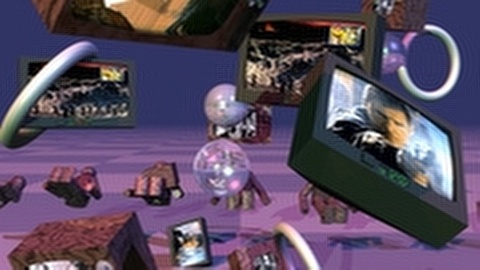
To get the full result of this document, use a display device that can show at least 16-bit colour. Otherwise the subtler differences will disappear.
Note: Because the concept of pixels do not directly apply to analog devices, the numbers for all but DVD and CD-I are close approximations.
As said earlier, this comparison is made for NTSC. It is, however, valid also for PAL: all resolutions are slightly higher, but the respective quality order of the video systems remains the same (although PAL broadcast is much closer to Laserdisc and DVD than NTSC broadcast).

See how ludicrously small the DVD image below looks when compared to HDTV? But, well, it's the best we have at the moment. So let's go on.
DVD has a nice feature: films can be encoded on the discs natively in a
16:9 format, giving you 720x480 pixels. The 16:9 format could actually
be used in any media, but because all DVD players can downscale the picture
to a normal 4:3 aspect ratio (with some loss of resolution) for use with
older TV sets, the feature is widely used.

This is DVD in the 4:3 mode, where the image is stored as letterboxed and
the resolution is down to 720x360:

Laserdiscs have a slightly worse resolution than a 4:3 DVD, at 560x360 pixels:

Broadcast is only 460x360 pixels.

VHS at 300x360 pixels. The interesting thing in VHS is that the aspect
ratio of the "pixels" is quite weird: about 1:2.

Last, and least, is CD-I with all of its 320x180 pixels. Add to this the
horrendous compression artifacts (that are not depicted here), and you can
now guess why there aren't any letterboxed films for CD-I.

HDTV:

Even DVD with 16:9 enhancement looks like garbage when compared to the
clarity of the HDTV signal. Just look at the smaller details:

DVD without 16:9 enhancement. Look how the fine details are slightly
worse than in the previous picture because 25% of the scanlines haven't
been used:

Laserdisc. See how the detail is still slightly getting worse. If you
compare this to DVD with 16:9 enhancement, you will see a noticable
difference.

Broadcast. Again there is a slight degradation of quality.

VHS. As you always knew, the difference to a good broadcast is stunning.

CD-I. Very little is left of the original image. Not quite HDTV, if I
may say.


Laserdisc is now quite close to DVD at 560x480:

Broadcast is slightly worse than LD at 460x480:

VHS bites the dust at 300x480:

And again, clearly last, is CD-I at 320x240. However, the difference to
VHS is not as great as you would think from the numbers, because CD-I
uses almost square pixels, whereas the "pixels" of VHS are very
much rectangular-shaped, and the limiting horizontal resolution makes the
picture look unsharp.


Laserdisc. Now that DVD doesn't have it's 33% better vertical resolution
edge, the systems look actually quite similar. However, in real life the
fact that information is stored on Laserdiscs in the composite domain and
on DVD in the component domain, will make the colours of DVD better.

Broadcast:

VHS:

CD-I:
